Fantastic salsa roja is easy to make, but it's also very easy to make it bland and unexciting without even realizing it. I must admit, for a very long time, I was making it incorrectly. Don't get me wrong; it was quite good, but my new salsa roja recipe quickly put it to shame. This salsa is so good that when I make it, we all crowd around the bowl and practically fight for it until the last drop. It's really, really freaking great.
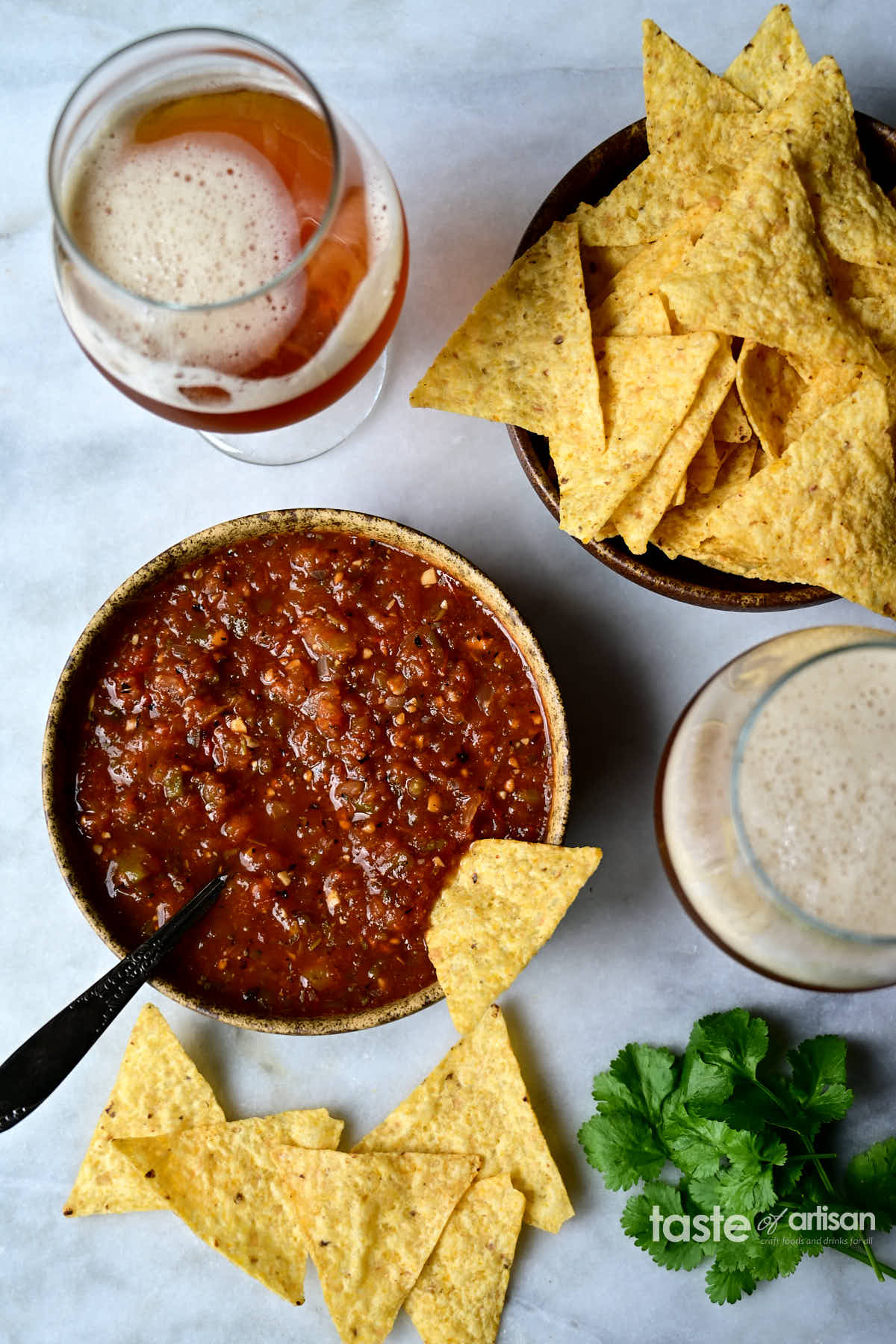
What is salsa roja?
Salsa roja, translated from Spanish as red sauce, is a type of spicy red sauce in Mexican cuisine. It is made of jitomate, translated from Spanish as red tomato, onion, garlic, chiles, salt, and pepper to taste.
How can you mess up salsa roja?
I can't speak for everyone else, but here are the mistakes that I was making:
- Using the wrong tomatoes
- Adding too much onion
- Chopping tomatoes and onions too coarsely
- Not roasting/charring vegetables
- Discarding charred skins
How to make fantastic salsa roja?
Pick the right tomatoes
In my humble opinion, the 'garbage in, garbage out' concept perfectly applies to making salsa. You can't make excellent salsa roja with mediocre tomatoes. No way, no how.
Tomatoes for salsa must be fully ripe, soft, and juicy. Hard tomatoes make lousy salsa. My best-tasting salsa is in summer when tomatoes are in season. Locally grown, vine-ripened tomatoes are best. Tomatoes ripened in the heat of the summer are the juiciest and the sweetest. These tomatoes make the best salsa.
If you have access to in-season, locally grown heirloom tomatoes, those will make outstanding salsa.
If you grow your own heirloom tomatoes, that's the perfect scenario.
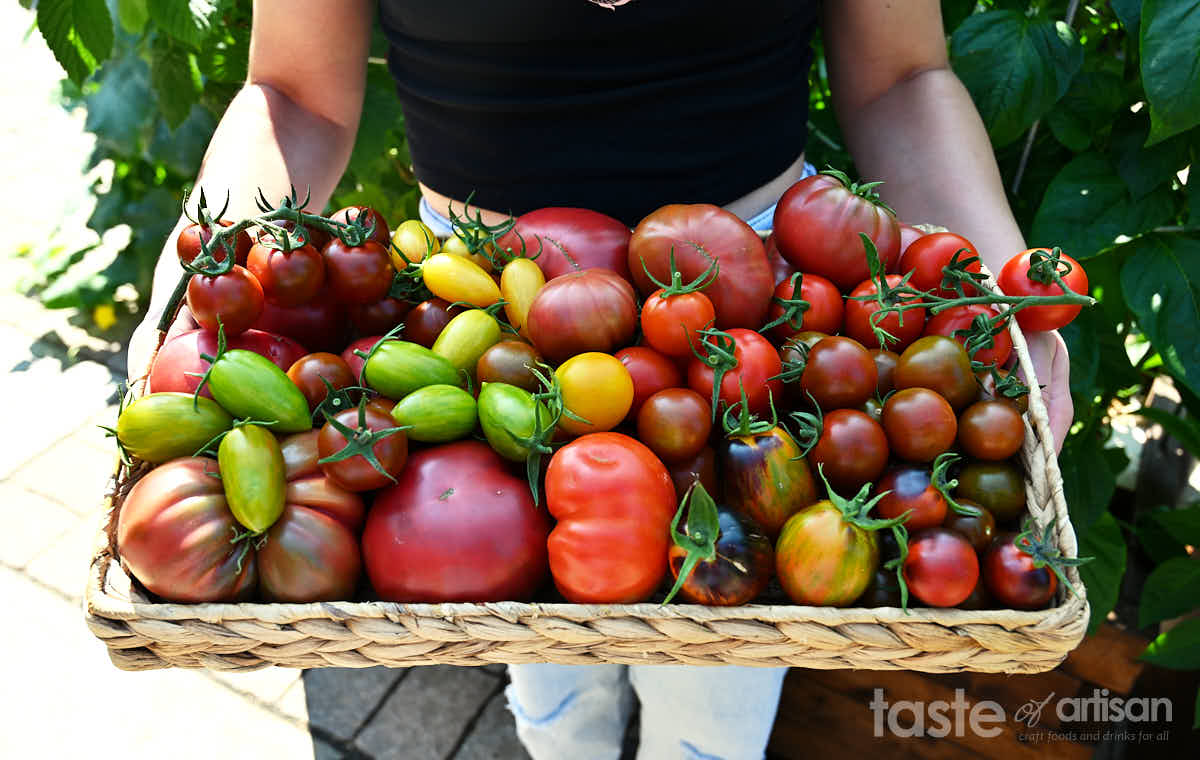
Add the right amount of onions and chiles
I used to eyeball the amount of onion in my salsa and would always, for some reason, end up with too much. Later, I realized that salsa roja is not about onions or chiles. No. Salsa roja is all about the delicious, juicy, sweet tomatoes ripened under the hot sun. Onions and chiles are there only to complement the tomatoes and enhance their flavor.
So, how much onion and chiles to add? Half an onion per pound of tomatoes is what I aim for now. One to two, maybe three, jalapenos or serrano peppers per pound of tomatoes, depending on how much heat you want. Poblano peppers aren't strictly required, but I love the spiciness and a slight sweetness that roasted poblano peppers add. One small or half a large poblano pepper per pound of tomatoes is enough.
Roast/char the vegetables
The secret of this amazing salsa roja recipe is not just the ingredients; it's how it's made. To get that extra complex flavor, you must roast the vegetables. Not only roasting adds robust flavor, but it also softens the veggies, improving their texture and making eating them also much more enjoyable. Fresh salsa doesn't mean the vegetables are completely raw. Roasting brings out the flavors and mellows out strong flavors and pungency of onions and garlic.
To get even more flavor, the skins of the vegetables must be charred. You want good charring on the outside and soft, unburnt flesh on the inside.
If you can roast the vegetables on a charcoal grill, throw a wood chunk (oak, hickory, pecan, cherry) in the pit to give your veggies a nice smoky flavor. That extra smoky flavor will make your salsa even more amazing.
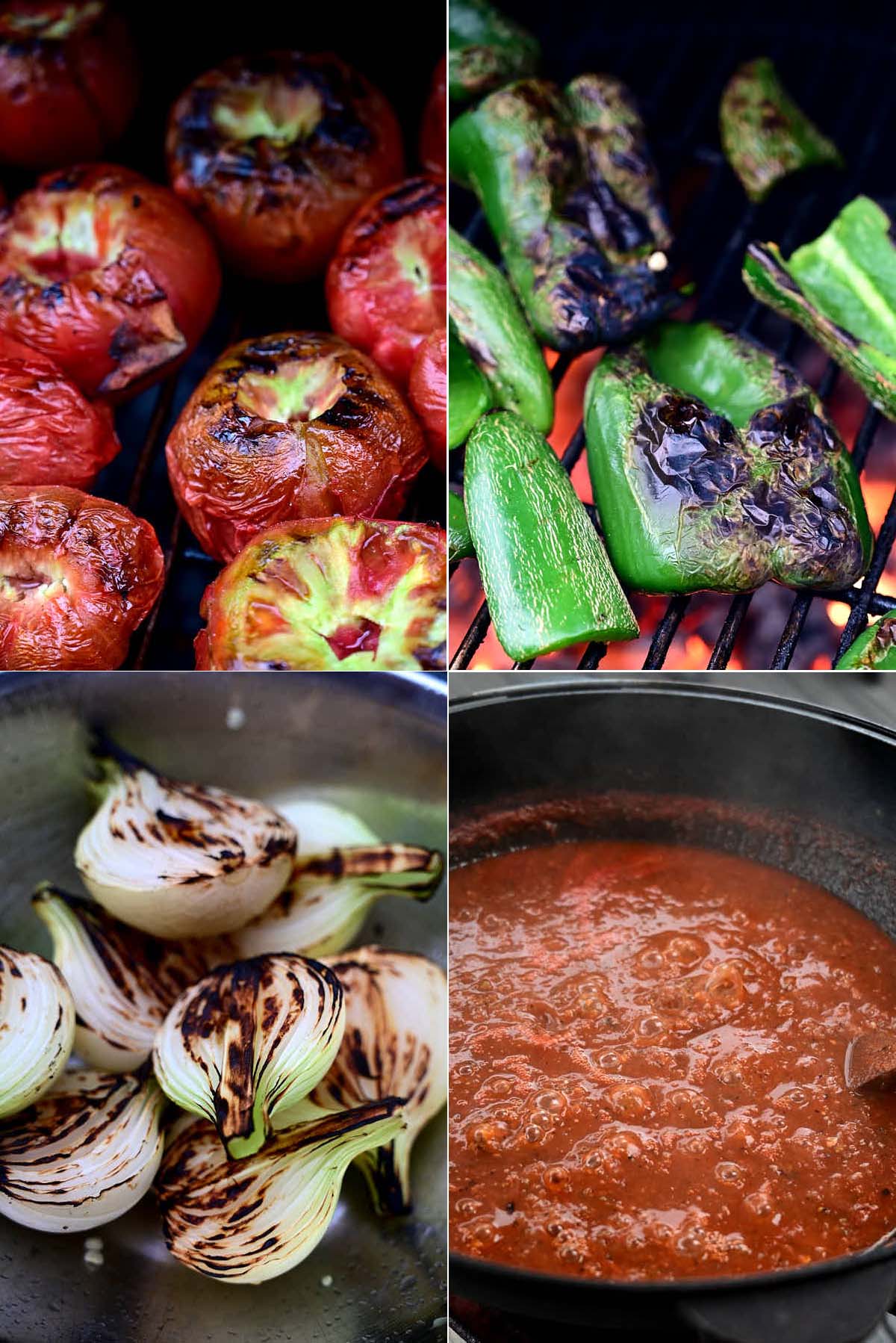
Tip: I like coring, seeding, and cutting chiles in half before roasting, allowing me to throw them in the food processor straight away. If you prefer, roast them whole, then let them cool down before coring and seeding, as they will be too hot to work with.
Do not discard the charred skins!
Some chefs remove the charred skins; some don't. I now always keep them. They add a great deal of rustic, complex flavor. They also darken the salsa, giving it a gorgeous dark red color. We eat with our eyes, and the color of this salsa roja will make you want to devour it.
Finely process the vegetables
Hand-chopping vegetables doesn't work as it doesn't provide a fine enough texture. You need a food processor. A blender will do too, but I find that it purees vegetables too much. You want a perfect balance of pureed veggies and slightly chunky ones. A food processor is perfect for this. If you use a blender, blend one part of the vegetables well while giving the other part just a few pulses.
You may ask, but how did they make proper salsa before all the electrical kitchen appliances were invented? Molcajete! You grind the ingredients in a molcajete. I own one, and I like using it to make authentic salsa roja when I have the time, but it's time-consuming, especially when making large batches.
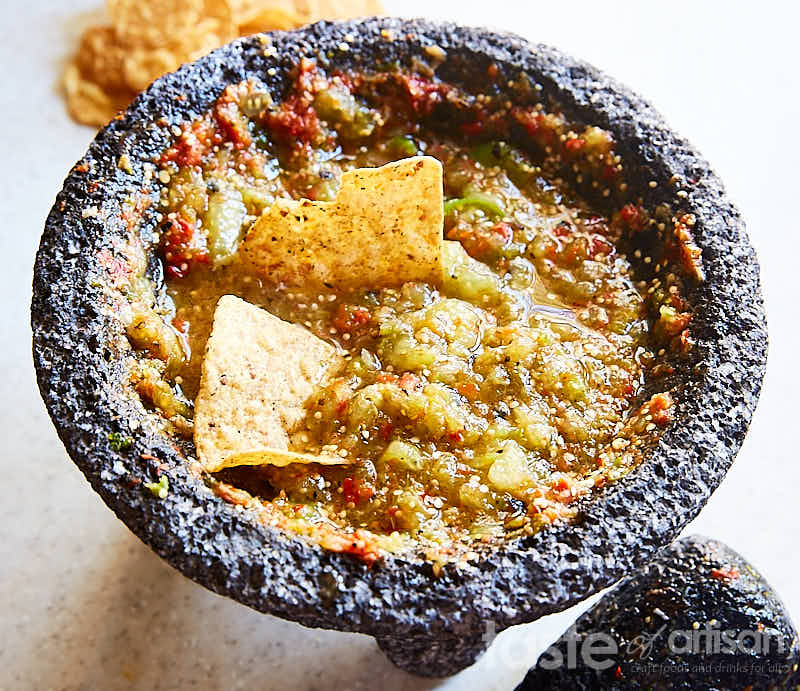
A food processor is quick and easy and does an excellent job.
Tip: process all the skins with some tomatoes and collected juices separately. Process until no large pieces remain, only tiny-tiny pieces. Large pieces of skins will make salsa less enjoyable.
That's all there is to it. I hope this helps you make a fantastic salsa roja.
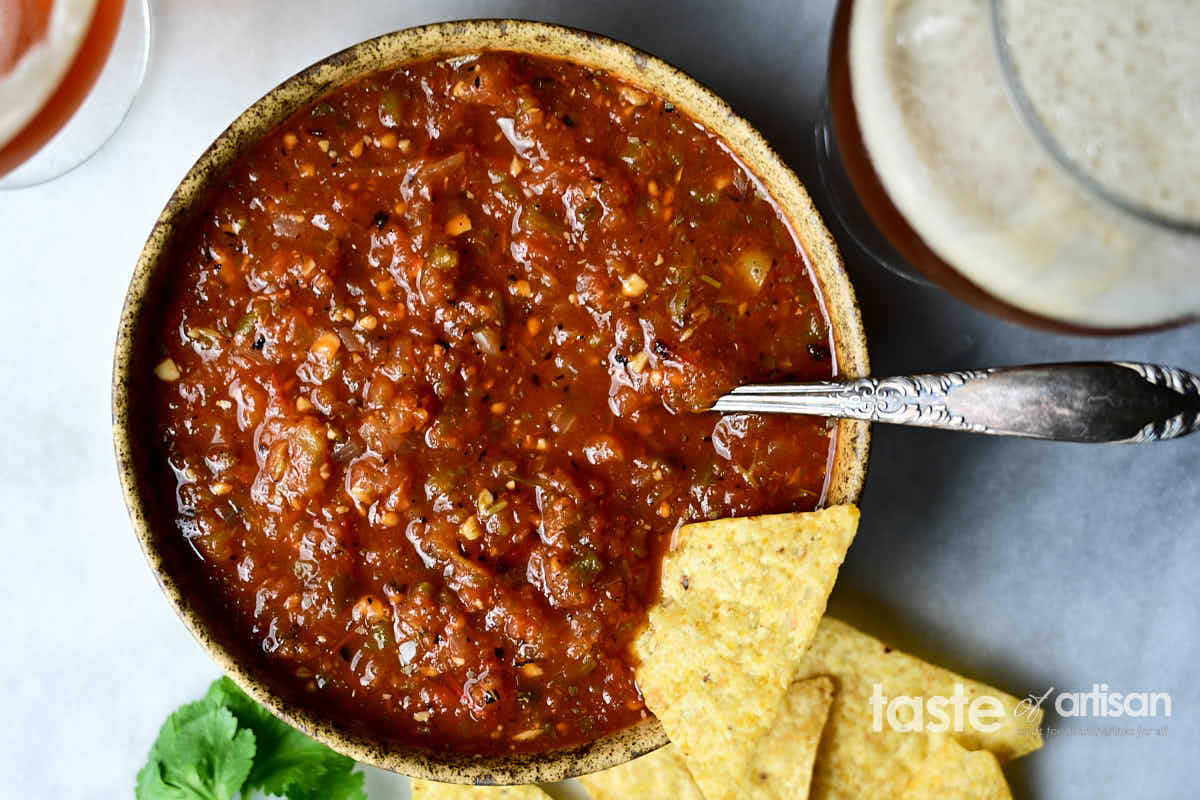
Preserving salsa
Where I live, tasty tomatoes aren't available outside of the narrow growing season, so I have to learn to preserve salsa. This is actually easier than most think.
All you have to do is add some white vinegar to make it safe for canning (I followed National Center for Home Food Preservation's guidelines for canning salsa), boil it for 10 minutes, ladle into jars, and process in a boiling water bath.
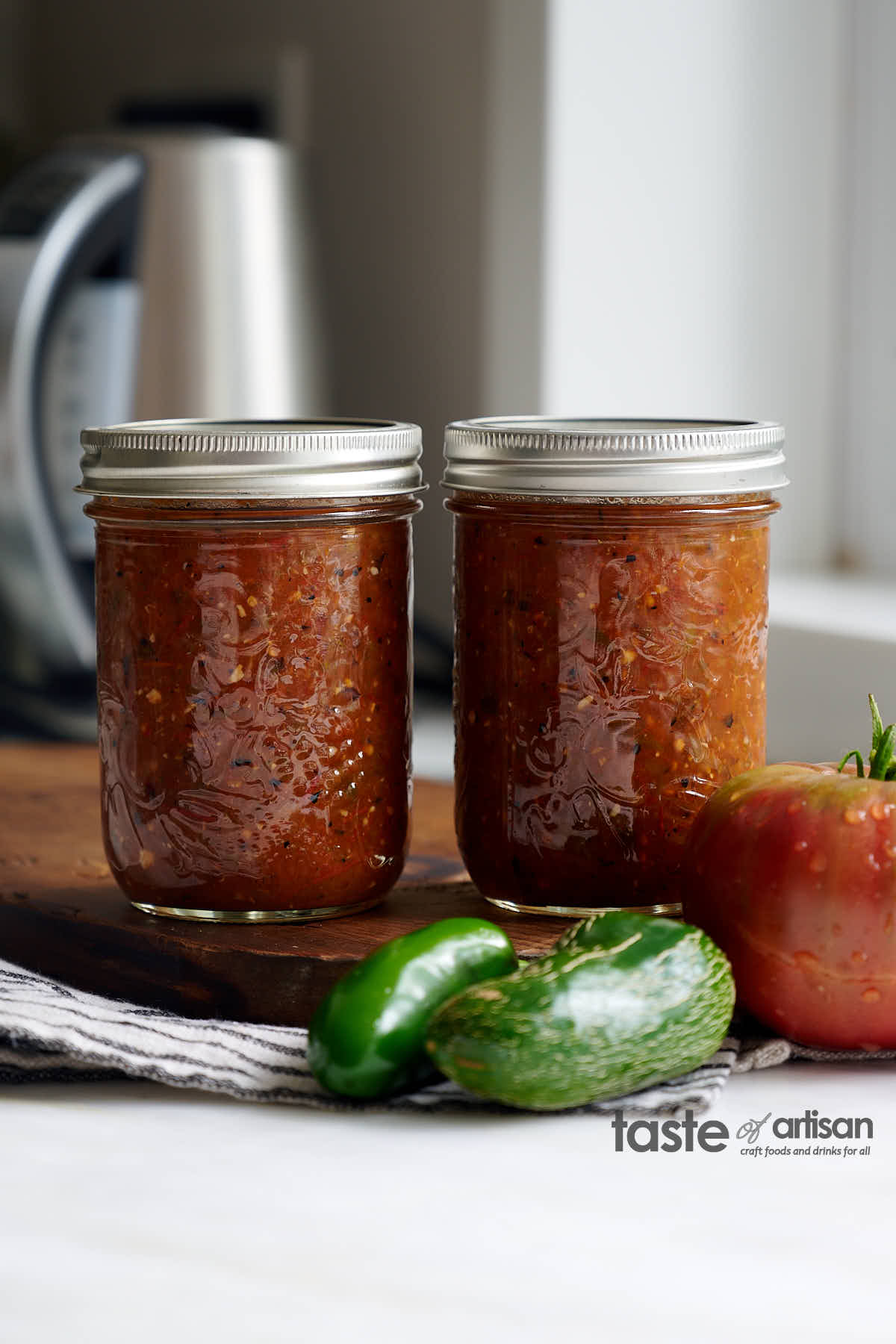
While adding vinegar, the necessary evil, makes salsa more acidic, and the cooking takes away some of the summery brightness, this canned salsa still tastes ridiculously good. It beats fresh salsa made with hard, bland greenhouse tomatoes and especially store-bought canned salsa. There is simply no comparison.
Enjoy!
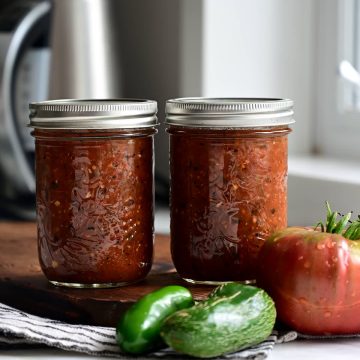
Charred, Smoky Salsa Roja (Fresh or Canned Recipe)
Print Pin RateIngredients
Ingredients for fresh salsa roja (makes about 4 cups)
- 2 lbs tomatoes cored, but not peeled
- 1 poblano pepper cored and seeded, cut in halves lengthwise
- 1 medium onion cut in half
- 1 jalapeno pepper plus more to taste
- 1/2 cup chopped cilantro
- 2 garlic cloves
- 1 1/2 tsp salt or to taste
- 3/4 tsp white pepper
Ingredients for canned salsa roja (makes about four 1-pint jars or 8 cups)
- 4.5 lbs tomatoes cored, but not peeled
- 1/2 lb poblano peppers cored and seeded, cut in halves lengthwise
- 1/2 lb onions cut in halves
- 2 jalapeno peppers plus more to taste; cored and seeded, cut in halves lengthwise
- 4 garlic cloves
- 1 cup chopped cilantro
- 3 tsp salt or to taste
- 1 1/2 tsp white pepper
- 10 Tbsp 5% white vinegar do not change the amount of vinegar
Instructions
To make fresh salsa roja
- Preheat the broiler. Place the tomatoes, garlic cloves, onion halves (cut side up), and chiles (skin side up) on a baking sheet lined with foil. Broil on the top rack. Remove garlic cloves after 4-5 minutes once they get brown. Broil tomatoes and chiles for 6-8 minutes until the skins are nicely charred, flip and broil for another 6-8 minutes. Broil onions for about 10 minutes until the tops are nicely charred.
- Alternatively, you may roast and char your vegetables on a cast iron pan over medium-high heat.
- Better yet, do that on a gas or charcoal grill. Make sure the grate is as close to the heat source as possible. If using a charcoal grill, add a few wood chunks (oak, hickory, pecan) for the vegetables to acquire a smoky flavor.
- Place the vegetables in a food processor, along with the salt, white pepper, cilantro, and any juices. Process for about 15-20 seconds until the texture is smooth. Taste for heat, and add more charred jalapenos if necessary.
To make canned salsa roja
- Place fresh salsa made using the steps above into a large pot, add the vinegar, and bring to a boil over medium-high heat, frequently stirring.
- Once the mixture is boiling, lower the heat and cook for 10 minutes.
- Meanwhile, sterilize jars and lids with rings.
- Ladle the salsa into the prepared jars leaving a 1/2" headspace. Wipe the rims, put the lids and the rings on, and tighten finger-tight.
- Process in a boiling water bath for 15 minutes (0-1,000ft) or 20 minutes at 1,001 - 6,000 ft and 25 minutes above 6000 ft.
- Let the jars cool down at room temperature for 12-24 hours, remove the rings, check the seals, and store them in a warm, dry, and dark place for up to a year for optimum freshness.
- Once open, refrigerate for up to 2 weeks.


Shelly says
Sorry if this gets duplicated. Loved the recipe and finished 1st batch of the season using early girls. Wondering if using citric acid instead of lemon juice would allow the other flavors to come out more and reduce the lemony zing!! Thoughts?
Victor @ Taste of Artisan says
Hi Shelly, answered this in the previous comment. Hope that helped a little. I am not a fan of lemony/limey salsa, so I only use vinegar by the way.
Shelly says
Thanks Victor. Yes sorry for the duplication. I might go the route of getting a ph meter and possibly I wouldn't need as much lemon juice based on final ph level. I think next batch I'll use vinegar and see how I like that. I switched to lemon juice years ago but it might be time to give vinegar a shot at making it into my next batch! Appreciate the tips and info. Happy Canning!
Victor @ Taste of Artisan says
You are welcome, Shelly. Yes, definitely get a good pH meter, it's worth it. I tried both lemon juice and vinegar for canning salsa and I prefer the taste of white vinegar. Nothing more than a personal taste preference. Good luck canning!
Shelly says
One correction, 1/4 tsp citric acid to 1 tbl lemon juice...
Shelly says
Just finished my first batch of mild salsa today! While I like the flavor, wondering if I used citric acid instead of lemon juice or even do half and half next time (1/2 tsp citric acid to 1 tbl lemon juice) in order to reduce the lemony zing 🙂 Thoughts?
Victor @ Taste of Artisan says
Shelly, this is a very good question. When I post recipes such as this, I follow the National Center for Home Food Preservation's guidelines for safety reasons. They, I believe, only recommend using bottled lemon/lime juice or vinegar, and have many example recipes on their website. You can check their Salsa Canning resource with some sample recipes. Their may be one with citric acid that I missed, but I don't believe there is one.
Now, here is something else to think about. Canned food, such as salsa, has to have final pH of 4.6 or lower (measured after canning is done if I am not mistaken) to be safe for canning using water bath method. Using a reliable pH meter, one can, technically, use only enough acid of their choice, to get to that level or slightly below, to get a perfectly safe salsa that is not overly acidic or uses acid that may not be desirable for some, e.g. some like vinegar but not lemon/lime juice.
I am not qualified to recommend using this method, so I won't. It is also highly dependant on the accuracy of the pH measurement. I always recommend following official guidelines for canning safety, but I have used it myself at my own risk. A lot the tomatoes that I grow are acidic enough and I usually have to add only a fraction of the recommended amount of acid to get the pH to the desired level. Good luck!
Matt P says
Thanks for the recipe. I loved the smoking process. I used the canning recipe but modified the recipe a little to ensure a depth of smokey flavor but also a rounded taste. I used early girl tomatoes from my garden, which are a little more watery than plum tomatoes, but it worked out. I increased the garlic by a clove and added a good sized Serrano pepper to the smoker. I have a Treagger smoker so I first smoked the veggies for about 30 minutes at the smoke setting and then cranked it up to the hottest temp for about 20 minutes (give or take). My make smoker temp was about 375. While the veggies did not char much, the skins had a great smokey flavor. I also took a dried Guajillo pepper, stemmed and seeded it, then ground it. I took fresh cherry tomatoes and cut them up to rehydrate the pepper and bring some brightness to the salsa. Last mod was I used a large amount of fresh Green onion (maybe a cup) in the food processor. This is the best salsa I've ever made and will be making this from now on. Thanks again!!
Victor @ Taste of Artisan says
Glad you like it Matt. Thanks for the detailed feedback and tips. I haven't thought about about using my smoker for this, so thanks for that great idea. I find that charring tomatoes and peppers is a lot easier in the oven under a broiled. I am not sure if electric will give the same effect, but my gas broiled chars them very nicely in about 8-10 minutes.
I've also been experimenting this year and used a combination of Poblano, Mojo, Jalapeno and my favorite very aromatic sweet Ajvar peppers. There are so many possibilites. I also used home grown Sicilian red and white onions and some Creme Brule shallots. I really liked the flavor.
For tomatoes I used primarily Indian Stripe, Pink Brandywine and some other varieties that I had growing in my garden. I chopped them and let them set in a colander over a large bowl to drain off some of the juices. That helped make salsa thicker. I did add some of the Juice back to achieve the desired thickness.
Enjoy!
~Chrissie O. says
The flavor of this is ridiculously good! I actually didn't just "broil" the veggies - I preheated oven to 425 and legit oven-roasted them for about 20-25 minutes. The onions were gorgeous, the peppers (I just quartered them) had a lovely char, and the roasted tomatoes got so deliciously sweet!!! Amazing!!! 24 hours in the fridge, and the flavor is even more intense!!! Don't skip the poblano (I also added a Hatch!), and if you want more intense cilantro flavor, use the stems!!! SO GOOD!!!
Victor @ Taste of Artisan says
Glad to hear it, Chrissie. I love this salsa, that's the only one I eat now as nothing else, plain or fancy, doesn't even come close. Already canned two dozen jars and will be doing more once the second flush of tomatoes gets going. Enjoy!